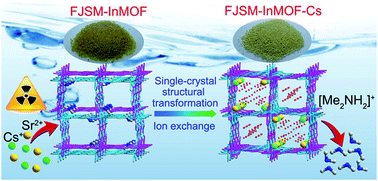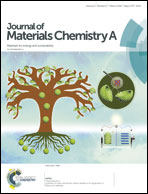An easily synthesized microporous framework material for the selective capture of radioactive Cs+ and Sr2+ ions†
Abstract
It is of vital importance to capture 137Cs+ and 90Sr2+ from solutions for radionuclide remediation due to their hazardous nature and long half-life. Although metal organic framework (MOF) materials have been greatly developed, the studies of their application in the capture of radioactive cations remain rare. Especially, the capture mechanism has not been clarified. Here, we present a new In-MOF material with the potential for remediation of radioactive Cs+ and Sr2+ ions by ion exchange, namely, [Me2NH2][In(TDC)2]·1.5DMA·1.5H2O (FJSM-InMOF; H2TDC = 2,5-thiophenedicarboxylic acid and DMA = N,N′-dimethylacetamide). It possesses an anionic framework of [In(TDC)2]nn− charge balanced by dimethylammonium cations. It could be easily synthesized via a one-pot solvothermal route. Remarkably, it showed excellent β and α radiation-resistances, high exchange capacities (qCsm = 198.63 mg g−1; qSrm = 43.83 mg g−1), impressive selectivity (KCsd = 7.50 × 104 mL g−1; KSrd = 9.49 × 105 mL g−1), high ion-exchange efficiency (RSr = 99.89%; RCs = 99.63%) and the ability of convenient elution with low cost. In particular, the ion exchange mechanism was illuminated by an unprecedented observation of the single-crystal to single-crystal structural transformation in the Cs+-exchange process. This work paves the way to develop highly efficient and environmentally friendly MOFs for the selective capture of radionuclides.



 Please wait while we load your content...
Please wait while we load your content...